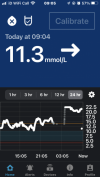Yesterday I went to my second session in the local equivalent of DAFNE, and they told us about the Glucomen Day CGM; it's now available on the NHS in my area and, having done a little googling, a number of other areas too.
On the accuracy issue: there has been a small study,
https://www.ncbi.nlm.nih.gov/pmc/articles/PMC8869704/pdf/biosensors-12-00106.pdf . The study was funded by Glucomen's manufacturers, but carried out by medical academics. (And one of the authors of the study is on the advisory board for Libre's manufacturer, but not Glucomen's manufacturer! None of the other authors has any industry links.) Accuracy was assessed by the gold-standard laboratory instrument, not just the blood glucose meters we use. The gist seems to be that the Glucomen CGM is about as accurate as Libre 2 or Dexcom G6.
There are four things about the Glucomen I quite like the sound of, as compared to Libre 2:
- The applicator and the transmitter are reusable, for up to 5 years, so there's about 90% less waste than with the Libre 2. Not only less plastic waste but less battery waste; every Libre 2 sensor contains a battery, so you're just throwing one away every fortnight.
- More options for where to wear it. At the time Lucyr was testing it, it was only licensed for wearing on the abdomen; but, as of October 2022, it's licensed to wear on the abdomen or upper arm or lower side. For me, wearing on the abdomen would be great-- I never sleep on my front but often sleep on one side or the other.
- I note there have been some quibbles in this thread about the strict technical meaning of 'calibration'! But, using 'calibrate' in the loose sense: I like the idea of being able to 'calibrate' the sensor with BGM readings. I've often wished I could 'tell' the Libre when my BG reading is very different from the Libre reading; well, with the Glucomen, you can. (In fact it asks you to do that at least once every 48 hours.)
- Not having to scan.
The downsides seem to be:
- The sensor's not quite as flat as the Libre sensor.
- The sensor needs to be within 10 feet (3 metres) of your phone to transmit data, whereas for Libre 2 it's 20 feet (6 metres). But I'm already used to not wandering away from my phone too far for too long. And with the Glucomen you can not only turn the 'signal loss' alarm on or off but also customise the timing; with the Libre, if the 'signal loss' alarm is on, it's 20 mins, non-adjustable.
- Like Libre 2, Glucomen can't be integrated with a pump.
I'm mulling it over ... Has anybody else tried it?

